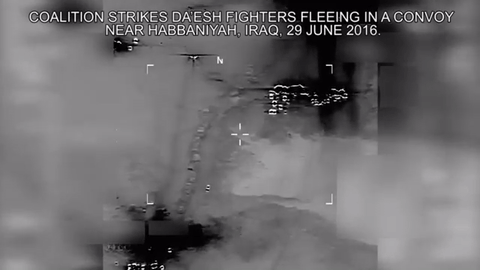https://warisboring.com/the-attack-on-an-islamic-state-convoy-is-a-tactic-as-old-as-war-1c53109896ab#.9uah0gcp8
by ROBERT BECKHUSEN
As the Iraqi army overran the last of Fallujah’s neighborhoods remaining in the Islamic State’s hands this week, more than 500 vehicles left the city and headed toward Syria. Along a desert highway, the convoy came under aerial attack.
What followed now appears to be the destruction of one of the largest single concentrations of Islamic State fighters and equipment seen so far in the war, and may count among the group’s worst defeats.
U.S. and Iraqi officials cited by the Washington Post claim more than 150 vehicles were destroyed in attacks on two separate parts of the convoy.
It’s unclear how many people died, although one estimate from U.S. officials places the number at 250 Islamic State fighters. Some fighters, according to eyewitnesses, stripped off their clothes and fled into the desert.
An Iraqi Mi-28 Havoc gunship, Cessna Caravan ground-attack planes and U.S. warplanes joined in the attack. A video released by the U.S.-led coalition shows bombs hitting one convoy, which strikes in different sections before more bombs and explosive rounds strafe the highway.
Videos and imagery released on Iraqi social media show bodies of men, some wearing camouflage, lying along a road where the second of two convoys was attacked. Abandoned, wrecked civilian vehicles — a few converted into armed “technicals” — littered the road.
 Operation Inherent Resolve capture
Operation Inherent Resolve capture
“We are still trying to determine Da’esh’s motives,” Pentagon spokesman Col. Chris Garver told the Post. “What I can say is that we know that Da’esh is well aware of what happens when it assembles into large convoys in the open — coalition and Iraqi air forces are able to strike them to great effect.”
It’s unclear if civilians were killed in the convoy, although it is certainly possible.
Iraqi Brig. Gen. Yahya Rasoul said that the Islamic State fighters were traveling with their families, and the Post reported that “coalition aircraft avoided a part of the convoy [the coalition] thought could contain civilians.”
Attacking retreating troops is ugly, grim … and legal.
The Geneva Convention prohibits killing surrendering troops, but omits retreats. The distinction being that retreating soldiers are still enemy combatants, even if they are not shooting at anyone at that moment.
The U.S. Naval Handbook notes that “the mere fact that a combatant or enemy force is retreating or fleeing the battlefield, without some other positive indication of intent, does not constitute an attempt to surrender, even if such combatant or force has abandoned his or its arms or equipment.”
If the Islamic State fighters were traveling with civilians — possibly against their will — then the group would have violated the laws of war by “utililizing the presence of a civilian or other protected person to render certain points, areas or military forces immune from military operations,” according to the International Criminal Court’s statutes.
Military history is replete with examples of armies being attacked on the run. Historically, routing is when a military organization experiences its heaviest losses — and advancing armies will often exploit retreats to inflict as much damage as possible.
During the Persian Gulf War, U.S. and Canadian warplanes killed hundreds of retreating Iraqi troops as they fled Kuwait on the Highway of Death. Some 1,800 to 2,700 vehicles were destroyed during 10 hours of bombing.
After the Normandy invasion, Allied armies surrounded and annihilated the German Seventh Army and the Fifth Panzer Army around the French town of Falaise. While German troops attempted to break out, Allied aircraft bombed their convoys.
Afghan tribesmen inflicted one of the worst defeats in British military history during the 1842 retreat from Kabul. Around 4,500 British troops and 12,000 civilians lost their lives in the Hindu Kush mountains in repeated ambushes. On a much larger scale, Russia repeatedly attacked Napoleon’s army during his 1812 winter retreat. Around 400,000 French troops died.
The list goes on. In 490 B.C., the Athenians massacred thousands of Persian soldiers as they fled during the Battle of Marathon.
It’s also perhaps easier, psychologically, to kill a fleeing enemy.
In his 1996 book On Killing, Dave Grossman observed that executioners will often blindfold or mask their victims to lessen the mental trauma of shooting them. The same phenomenon appears to make it easier for soldiers to shoot their enemies when they flee with their backs turned.
“There is a chase instinct in most animals that will cause even a well-trained and nonaggressive dog to instinctively chase and pull down anything that runs,” Grossman wrote. “As long as your back is turned you are in danger. In the same way, there appears to be a chase instinct in man that permits him to kill a fleeing enemy.”
Abundant video evidence from the wars in Iraq and Syria shows that firing on retreating soldiers is a common practice by all sides of the conflict.






No comments:
Post a Comment